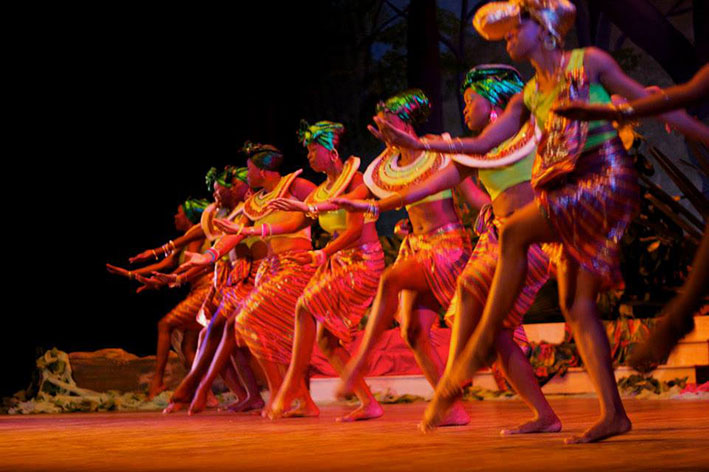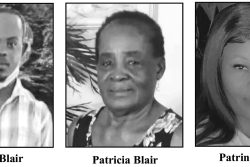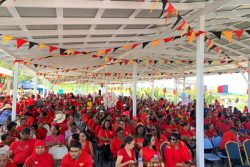 The Institute of Creative Arts (ICA) will celebrate its fifth Convocation on Thursday, September 20, 2018. This is an important academic milestone for the Institute and for its four schools. But it is also a signal of the advancement in training in the literary, visual, and performing arts in Guyana, and another step in the harmonisation of tertiary training in the arts with developments across the Caribbean.
The Institute of Creative Arts (ICA) will celebrate its fifth Convocation on Thursday, September 20, 2018. This is an important academic milestone for the Institute and for its four schools. But it is also a signal of the advancement in training in the literary, visual, and performing arts in Guyana, and another step in the harmonisation of tertiary training in the arts with developments across the Caribbean.
Years ago, the Caribbean took a new approach to the arts as a recognised career, as an industry, as economic factor, and as academic study. This was a significant development over old attitudes that saw art as purely decorative, art as its own reward, art for its own sake, and as a mere pastime. The general change of attitude has been registered at various levels and in different ways.
At the highest political level was the topics on the agenda of COHSOD, the statutory inter-governmental body of CARICOM dealing with matters of social and human development (one of its other complementary councils dealing with trade and economics is COTED). The COHSOD ministers recognised artists as professionals and as regional workers to be accorded “hassle free” travel and “freedom of movement” among CARICOM states.
Training in the arts and recognition of studies in the arts as academic pursuits received considerable acceleration decades ago with the establishment of training institutions around the West Indies and deepened links with higher education and universities. The old Jamaica School of Art, the School of Music joined forces with the Jamaica School of Drama and the newer School of Dance to form what is now called the Edna Manley College. This institution forged an articulation with the University of the West Indies for the offer of degree programmes.
Similar developments took place in Trinidad and Tobago in two separate institutions. One was the creation of programmes in the UWI St. Augustine Department of Liberal Arts, which outgrew that placement to be the Department of Creative and Festival Arts offering even higher degrees. Additionally, a number of colleges were amalgamated under the University of Trinidad and Tobago and were housed at the newly built National Academy of the Performing Arts (NAPA).
In Barbados developments were along similar lines. The Barbados Community College was there, but that institution then elevated its offerings in both drama and the fine arts. The most recent extension of these advancements was the creation by the UWI, Cave Hill, of the Errol Barrow Centre at Cave Hill with an enhanced programme in the performing arts.
All of these were (are) linked by a network because there were advancements in this kind of training taking place at the secondary schools level. CXC created the Theatre Arts as an examinable subject and a curriculum of some depth in the school system. Later (very recently) the CAPE programme in Performing Arts was established.
In all of this, there was the growing need for trained persons to conduct the drama, dance and music in the secondary schools for these exams. Similarly, the demand extended to the higher levels.
The ICA in Guyana was founded in the Department of Culture in 2014 in an initiative under then Director of Culture James Rose. It created an organisation that brought together the four existing schools under one umbrella. The oldest is the National School of Dance which was established in 1974. The E.R. Burrowes School of Art was founded in 1975. The National School of Music came into existence in 2011, while the newest of them is the National School of Theatre Arts and Drama which was launched in 2013. All of these now operate as the ICA and will collectively graduate their students at the ICA Convocation for the fifth time.
Students will graduate in a variety of programmes. The Diploma in Theatre Arts and Drama and the Diploma in Creative Writing; the ICA Diploma in Dance and the Certificate in Dance; the Diploma in Fine Arts, the Certificate in Fine Arts, in addition to Certificates for Evening Students and special programmes; the ICA Diploma in Music and the ICA Certificate in Music as well as the ABRSM Certificates at various Grades.
In Thursday’s Convocation the proceedings will be presided over by The Visitor, Al Creighton. Each of the four schools will present their graduands to the Principal of the ICA – Ms Tamika Boatswain, who is also the Director of Culture. Boatswain is the Director of the National Museum and now heads the Department of Culture, and oversees the ICA. The Schools will petition the Principal by presenting their graduands and, at the call of the Visitor, she will confer upon the graduates, the diplomas and Certificates.
There will also be prizes for the Best Graduating Student in each of the Schools in addition to other awards for best performance in different individual subjects or disciplines.
This Convocation is a good opportunity for the work of the four schools to be highlighted, and to give the public greater familiarity with the institution, which operates as one of the cultural establishments coming out of the Department of Culture. These include the National Drama Festival, the GVACE, various music and dance festivals. Some of these are associated with the four Schools.
Carifesta
The National School of Dance was founded in 1974 at a time when Guyana, and in fact, the Caribbean was riding on a high wave propelled by Carifesta in 1972 and much resulting cultural cooperation among Caribbean states. This included political alliances, particularly with Cuba and Haiti. Guyana, in particular, continued the links which brought dancers and dance instructors from both of those countries, including the famous Lavinia Williams of Haiti, who was instrumental in training a corps of local dancers and choreographers and establishing organised training in dance out of which the National School of Dance emerged. This was the same wave that saw the start of the National Dance Company in 1979 and a few private companies like the Shah sisters of “Nrityageet” fame.
The Dance School runs classes from Early Childhood through the age groups up to the Advanced Level of dance proficiency. Students can attain a technical certificate in dance proficiency, and several leading dancers have done that. Since the establishment of the ICA, however, the school offers the ICA Certificate in Dance, and the higher level ICA Diploma in Dance which draws from those with the academic requirements for entry to ICA programmes. It is from these that the graduating class will come on September 20.
The E.R. Burrowes School of Art (B.S.A.) emerged from that same wave that created the circumstances that fueled the formation of a public dance school. There were similar artistic co-operations, but the School of Art was founded by Denis Williams who became the Director of Art in the then Department of Culture /National History and Arts Council. The school was named after Burrowes who was a leading member of the early developments in local art which may date back to the 1940s, and in particular to 1951 when the National Collection began with Williams’ painting Human World.
Significantly, the B.S.A., is now managed by one of the first sets of students that emerged from the early years of the school who went on to become prominent Guyanese artists. Ivor Thom is the Administrator, and he is the designer and builder of the Monument to the 1823 Slave Revolt. This is one of the current prominent pieces of public art (which includes Philip Moore’s 1863 Monument). Thom rose from the early B.S.A. and received further training overseas to where he will now present the 2018 batch of graduating art students at the Convocation. The artist currently in charge of Castellani House, Ohene Koama was also one of those first graduates.
The School of Art runs many programmes including the ICA Diploma in Fine Arts, and the Certificate in Art. These are programmes that have been in existence at the school and were adapted to the ICA after 2014.
Pioneering
What is of further interest is that both the National School of Dance and the National Dance Company have Directors who emerged as students when the dance school was founded. Linda Griffith is Director of the dance school and was also honoured when she was made an Honorary Fellow of the ICA. She emerged from the pioneering group of students in the Dance Teachers course and that set off the national school. Vivienne Daniel, who was also inducted as a Fellow of the ICA, also developed from that group of student dancers and choreographers to become (with Griffith) one of the two most prominent national choreographers. Daniel is the Director of the National Dance Company and the leading choreographer.
The National School of Music is the result of much later and more recent developments. It was decided to establish a forum for national training in music and the need was seen for a public school to offer such training. Before that, only training by private tutors was available. The Department of Culture under then Director of Culture James Rose established the School of Music. At this week’s Convocation the graduands in Music will be presented for the receipt of diplomas and certificates by Administrator Andrew Tyndall.
Tyndall is the founder of the National Steel Orchestra, that brings together trained musicians and now operates as the foremost professional steel band in the country. It functions out of the School of Music. As far as the training programmes go, there are different courses offered. The school offers a scheme of ongoing training to students over 14 who are prepared for the ABRSM overseas exams. However, the school now offers, additionally, the ICA Certificate and Diploma. The School has had inputs from other leaders in the field such as a former Director of Studies Assistant Commissioner Cecil Bovell. It is now responsible for a wide range of activities in national music development and performance.










